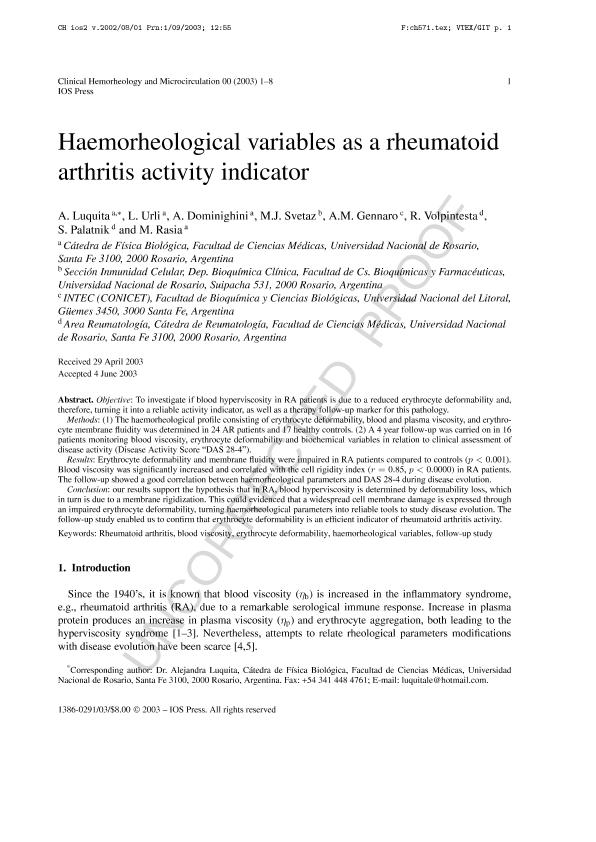Mostrar el registro sencillo del ítem
dc.contributor.author
Luquita, A.
dc.contributor.author
Urli, L.
dc.contributor.author
Dominighini, A.
dc.contributor.author
Svetaz, M. J.
dc.contributor.author
Gennaro, Ana Maria

dc.contributor.author
Volpintesta, R.
dc.contributor.author
Palatnik, S.
dc.contributor.author
Rasia, M.
dc.date.available
2017-10-31T18:30:53Z
dc.date.issued
2004-12
dc.identifier.citation
Luquita, A.; Urli, L.; Dominighini, A.; Svetaz, M. J.; Gennaro, Ana Maria; et al.; Haemorheological variables as a rheumatoid arthritis activity indicator; IOS Press; Clinical Hemorheology And Microcirculation; 30; 1; 12-2004; 9-16
dc.identifier.issn
1386-0291
dc.identifier.uri
http://hdl.handle.net/11336/27269
dc.description.abstract
Objective: To investigate if blood hyperviscosity in RA patients is due to a reduced erythrocyte deformability and, therefore, turning it into a reliable activity indicator, as well as a therapy follow-up marker for this pathology. Methods: (1) The haemorheological profile consisting of erythrocyte deformability, blood and plasma viscosity, and erythrocyte membrane fluidity was determined in 24 AR patients and 17 healthy controls. (2) A 4 year follow-up was carried on in 16 patients monitoring blood viscosity, erythrocyte deformability and biochemical variables in relation to clinical assessment of disease activity (Disease Activity Score “DAS 28-4”). Results: Erythrocyte deformability and membrane fluidity were impaired in RA patients compared to controls (p<0.001). Blood viscosity was significantly increased and correlated with the cell rigidity index (r=0.85, p<0.0000) in RA patients. The follow-up showed a good correlation between haemorheological parameters and DAS 28-4 during disease evolution. Conclusion: our results support the hypothesis that in RA, blood hyperviscosity is determined by deformability loss, which in turn is due to a membrane rigidization. This could evidenced that a widespread cell membrane damage is expressed through an impaired erythrocyte deformability, turning haemorheological parameters into reliable tools to study disease evolution. The follow-up study enabled us to confirm that erythrocyte deformability is an efficient indicator of rheumatoid arthritis activity.
dc.format
application/pdf
dc.language.iso
eng
dc.publisher
IOS Press

dc.rights
info:eu-repo/semantics/openAccess
dc.rights.uri
https://creativecommons.org/licenses/by-nc-sa/2.5/ar/
dc.subject.classification
Otras Ciencias Físicas

dc.subject.classification
Ciencias Físicas

dc.subject.classification
CIENCIAS NATURALES Y EXACTAS

dc.title
Haemorheological variables as a rheumatoid arthritis activity indicator
dc.type
info:eu-repo/semantics/article
dc.type
info:ar-repo/semantics/artículo
dc.type
info:eu-repo/semantics/publishedVersion
dc.date.updated
2017-10-30T18:43:34Z
dc.journal.volume
30
dc.journal.number
1
dc.journal.pagination
9-16
dc.journal.pais
Países Bajos

dc.description.fil
Fil: Luquita, A.. Universidad Nacional de Rosario; Argentina
dc.description.fil
Fil: Urli, L.. Universidad Nacional de Rosario; Argentina
dc.description.fil
Fil: Dominighini, A.. Universidad Nacional de Rosario; Argentina
dc.description.fil
Fil: Svetaz, M. J.. Universidad Nacional de Rosario; Argentina
dc.description.fil
Fil: Gennaro, Ana Maria. Consejo Nacional de Investigaciones Científicas y Técnicas. Centro Científico Tecnológico Conicet - Santa Fe. Instituto de Desarrollo Tecnológico para la Industria Química. Universidad Nacional del Litoral. Instituto de Desarrollo Tecnológico para la Industria Química; Argentina
dc.description.fil
Fil: Volpintesta, R.. Universidad Nacional de Rosario; Argentina
dc.description.fil
Fil: Palatnik, S.. Universidad Nacional de Rosario; Argentina
dc.description.fil
Fil: Rasia, M.. Universidad Nacional de Rosario; Argentina
dc.journal.title
Clinical Hemorheology And Microcirculation

dc.relation.alternativeid
info:eu-repo/semantics/altIdentifier/url/https://content.iospress.com/articles/clinical-hemorheology-and-microcirculation/ch571
Archivos asociados
